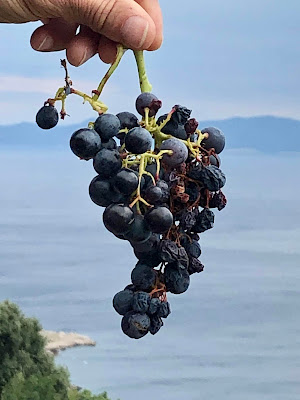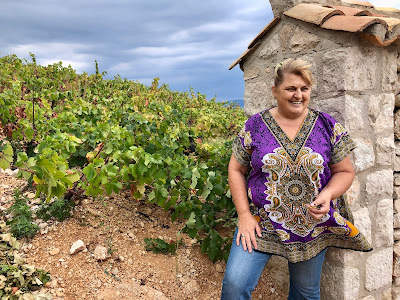The Pelješac peninsula, in southern Dalmatia and jutting out into the Adriatic Sea, has been known by several other names throughout history, such as Stonski Rat and Puncti Stagni. It is the home of the famed Walls of Ston, and the waters of the Bay of Mali Ston, which are the source of the delectable Ston Oysters (of which I enjoyed plenty while I was in Croatia).
This region, where 80% of their wines are red, is also famed as one of the best regions to grow Plavac Mali, the most commonly grown red grape in Croatia. Back in 1961, Plavac Mali was the first Croatian grape to have its own appellation, Dingač, located on the Pelješac peninsula. A Dingač wine must be 100% Plavac Mali, from vineyards the winery owns, and the wines must be submitted to the controlling authority for approval. The vineyards in Dingač are generally on steep, south-facing slopes. Also on Pelješac, Postup was its second appellation, created in 1967, and it too concentrates on Plavac Mali.
While we visited Pelješac, we stopped by the Peninsula Wine Bar, owned by the Bura-Mrgudić Winery and located in Donja Banda, to taste some of the local wines. Open to the public, you can taste over 60 different wines from Pelješac and the island of Korčula, as well as olive oil, homemade liqueurs and spirits, Croatian cheeses and meats. The participating wineries are generally, small, family-owned operations. The wine bar is a small and comfy spot, but with plenty of intriguing wines, and we enjoyed a number of diverse wines during our tasting. It's a fine spot to sample some of the best of the region.
Bura-Mrgudić Winery is run by siblings, Mare Mrgudić (pictured above) and Niko Bura, and the family's history with wine extends back at least five generations. They own vineyards on some of the best spots in the Dingač and Postup regions, though they are usually on very steep slopes, making harvest tough. In some spots, they have to use safety ties for their workers to ensure they don't fall down the slopes. In the first of the two pictures above, you can see one of their very steep slopes. Mare took us out to one of their vineyards, and she is said to be extremely knowledge about wine making. She was certainly very personable, and it's clear she has a strong passion for wine.
To accompany our tasting, there were cheeses, meats and olives, and I really loved the different cheeses. I need to learn more about the various kinds of Croatian cheese.
The 2018 Bura Rukatac was a fantastic value at the wine bar, at the equivalent of $6 U.S., and has been exported to the U.S. in the past, though its price here was probably closer to $20. It still would be a very good value even at that price. Made from 100% Rukatac grape, known as Marastina on Pelješac, the grapes are grown mainly in the valley of the peninsula. This wine was made in a more traditional manner, fermented with wild yeasts and spending four days on the skins. At 12% ABV, this wine has an alluring nose of savory aromas, and on the palate it is wonderfully complex and intriguing. Herbs and spaces, briny notes, a taste of apples and dried fruit, and even some subtle mineral notes. So much going on in this wine and most of us seemed enamored with this wine. Highly recommended! My only regret is that the wine bar was sold out of this wine so I wasn't able to buy any to take home.
The 2018 Bura Plavac Mali, also priced at $6 U.S., was also a killer value. At 13% ABV, the nose of this wine was also compelling, fruity with spice notes. On the palate, it was light and fresh, with delicious notes of cherry and plum, plenty of acidity, and a pleasing finish. This was probably one of the lightest Plavac Mali wines I tasted in Croatia, helping to show the diversity of this grape. I bought some of this wine to take home, and would easily have bought a case but they only had a limited supply. It's easy to understand why these two wines are so popular.
The 2018 Antunovic Rukatac is produced by a winery which was founded in 1994, though the family has a multigenerational history of winemaking. They currently own about 7 hectares of vineyards, growing Plavac Mali, Rukatac, and Pošip. With a 12% ABV, this wine had a pleasing nose of melon and white flowers. On the palate, it was fresh and crisp, with a tasty blend of citrus flavors, especially lemon and lime. It was an easy-drinking wine that would be perfect for the summer or with seafood. I've really come to enjoy the Rukatac grape.
The 2017 Boris M Violic Plavac Mali is produced by a winery that was founded in 2010, and currently owns about 4.5 hectares of vineyards, growing grapes such as Plavac Mali, Rukatac, Chardonnay and Tribidag. This wine is made in a more traditional style, spending more days upon the skins, and it is a bold but still elegant red wine. The black fruit flavors are dominant, rich plum and blackberry, with strong, but well-integrated tannins, mild spice notes, and a subtle herbal hint.
Also from the Bura-Mrgudić winery, the 2017 Marica Plavac Mali is considered part of their midrange, and it's made in a traditional fashion. Aged partially in oak, and at 14% ABV, it is a softer, elegant Plavac Mali with delicious black and blue fruit flavors, dark spice notes, and a lingering, satisfying finish. This would make for an excellent pizza or burger wine, an easy drinking red sure to please.
The 2016 Donja Banda Postup Plavac Mali was aged mostly in used French oak and has a 14.5% ABV. With rich black cherry and plum flavors accented by a spicy backbone, the wine is smooth will well-integrated tannins. It's a wine for steaks and hearty dishes, perfect for winter dishes.
The 2016 Vicelic Plavac Mali is produced by a small winery, with about 4.5 hectares of vineyards, mostly in the Dingač region. The family history extends back though to 1935, when their great-grandfather used to produce Plavac Mali, and his operation was the lasted in Pelješac at that time. This wine was aged partially in oak and had an aroma of dusty spice and subtle black fruit. On the palate, it was elegant and tasty, with plum and blackberry flavors, a touch of bitterness, spicy accents, and a lengthy finish. Another wine that would be best with beef and hearty dishes.
The 2016 Vicelic Dingač, made from 100% Plavac Mali, is produced more in an international style, spending about 14 months aging in new oak. At 14% ABV, the wine is rich with ripe plum and blackberry flavors, a strong spicy element, moderate tannins and a pleasing, lengthy finish. It is smooth and powerful, fine with a thick steak, though some might not care as much for its prominent spice notes.
In 2006, Robert H. Benmosche began planting vineyards, of Plavac Mali and Tribidag, in Pelješac, and has produced small amounts of these wines. Only 1500 bottles were made of the 2015 Benmosche Family Dingač, which has a 15% ABV, and is a big, bold wine, yet not overpowering. It has deep flavors of black fruit, with notes of raisins and black pepper, hints of herbs and a subtle earthiness. Such a compelling complex melange of flavors. A lingering finish, good acidity, and absolutely delicious. Highly recommended.
For the 2015 Benmosche Family Zinfandel, Benmosche imported some vines from a California nursery, but also had some very old vines of Croatian Zinfandel, aka Tribidag. At 15% ABV, this was a less bold wine, more elegant, with tasty plum and black cherry notes, mild spice hints, and well restrained tannins. Complex and interesting, there is also a freshness to this wine.
The wines of the Bura-Mrgudić Winery are definitely worth seeking out. And if you enjoy Plavac Mali, then you should explore the wines being made in Dingač and Postup. I'd like to explore the wines from this region in more depth, to gain a better sense of the differences in these two appellations, as well as to better understand Plavac Mali.















No comments:
Post a Comment